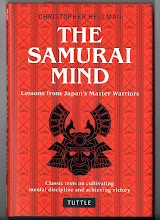 |
| Kuroda demonstrating battojutsu (screen shot from budojapan.com) |
Tributes to Kuroda Tetsuzan, master of the Komagawa Kaishin Ryu kenjutsu (as well as related schools of iaijutsu and jujutsu) have been slowly appearing online, marking the passing earlier this month of a martial artist of rare skill, who had polished and refined his skills, passed down through his family, into something quite unique.
I never met him or had any connections with his school, but he clearly displayed impressive and unusual body skills developed, as he explained, through strict adherence and analysis of the kata passed down to him. He was able to illustrate facets of these skills in a variety of ways, opening aspects of his art to those outside his school. Indeed, he was one of the pioneers of this approach in Japan, of bringing the body skills of traditional Japanese arts to a wider audience, through books, seminars and DVDs. Kono Yoshinori (who was a friend of Kuroda's) and Akuzawa Minoru (founder of Aunkai) are two others who were (and still are) similarly involved in making such skills more widely known, but it was Kuroda who kept strictly to the art that was passed down to him. He has preserved and passed on the kata he was taught, and it is these that he sees as being invaluable to developing the skills of former generations of bugeisha.
Watching him in action, his movements are clearly different from other schools of classical martial arts – the sudden change from one position to another and the very specific use of the body, for example. You can get a good idea of his concerns from an old (rather long but highly illuminating) interview by Stanley Pranin from the Aikido Journal. This is a short extract:
Since we stress kata [forms] training just as is done in other traditional Japanese martial arts, I don’t think there is anything that can be said to be particularly different in our method. I teach concrete, practical mental and physical techniques to enable students to realize the essence of the art through these kata.
A teaching called zegoku itto no koto has been transmitted in Japanese swordsmanship from olden times. When confronting an opponent one aims for a level where the movements of his mind and body control the opponent before he swings his sword. This is the highest level of swordsmanship. It seems to be a rather abstract spiritual teaching, but that’s not at all the case. It is an “invisible” technique which consists of advanced technical movements and the workings of the spirit based on these movements. All martial arts training begins with learning how to perceive this invisible element.
Kuroda Tetsuzan (2002)
https://aikidojournal.com/2002/08/26/interview-with-tetsuzan-kuroda/
The interview is from 2002, but from what I've seen, I assume his approach has not changed, however much his skills might have developed. What I think the interview gives is a sense of the importance of kata and how they can be used to develop particular skills. In these times when so much is available on video to be endlessly critiqued, when various forms of combat and combat sports are being practised and researched across cultures, when so many arguments are reduced to whether something works in sparring, it is not always easy to see the value of closely held secret methods of training or stylised kata that are not clearly (or clearly not) applicable to combat or self-defense. Some people have looked deeply into classical arts and derived real value from them, developing skills beyond the ordinary. Kuroda was one of those people.









